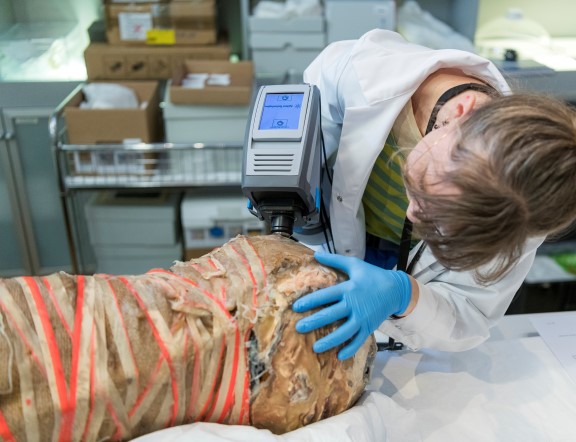What is art conservation?
Our conservators treat, document, and study the museum’s collections of paintings, paper drawings, textiles, decorative arts and design, installations, and electronic media.
The museum’s department of conservation has the principal responsibility for taking care of the objects in the museum’s collections. Among other things, this entails ensuring that the conditions during exhibitions, in storage facilities, or during transport help extend the lifetime of the works of art as much as possible.
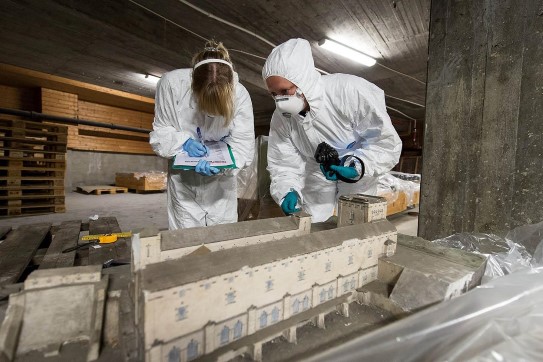
Sculptures and Installations
The National Museum’s collections of sculptures and installations encompass everything from “classical” stone and bronze sculpture to modern sculptures and installations.
Many of the National Museum’s more recent sculptures and installations use unconventional materials and methods. Some of the works also include kinetic elements.
A quick guide to conservation of sculptures and installations
-
1. Assessing the condition
Is the object undergoing a process of degradation? Has any new damage occurred? We document the condition of the piece in text and images and repair any damages that may have occurred, so that the sculpture is stabilized. Sometimes it may be necessary to analyse the object in order to identify the materials or techniques the artist has used, so that we may choose the optimal method of conservation.
-
2. Establish guidelines
We establish guidelines for how the objects are to be handled, displayed, stored, and packaged, so that its lifetime may be extended as much as possible.
-
3. Correct treatment
Many sculptures and installations contain industrially manufactured items, machines, or other gadgets that have been modified and repurposed. It is therefore essential to consult experts from other fields when the conservator’s own expertise falls short, for example when repairing neon lights, compressors, or cooling elements.
-
4. Documentation
In addition to combating the three main threats against the lifetime of the object, namely chemical, mechanical, and biological impacts, the conservator who works with sculptures and installations must actively document these objects.
Decorative Arts and Design
The National Museum’s collections of decorative arts and design span a period of time from antiquity until today.
The fields of decorative arts and design encompass numerous disciplines and an even greater variety in the materials used. The National Museum’s collection includes items from a wide range of genres, such as jewellery and objets d’art made from precious and base metals; wood and ivory carvings; glass objects and ceramics; furniture, mirrors, and other furnishings; and industrial design in all kinds of materials and styles.
Most of the disciplines build on traditional arts and crafts, but more recent items in the collection often blur the disciplinary boundaries in regard to material, technique, and style, so that the boundaries are not as clear-cut.
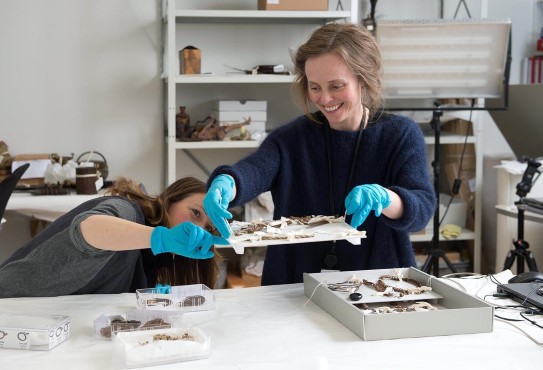
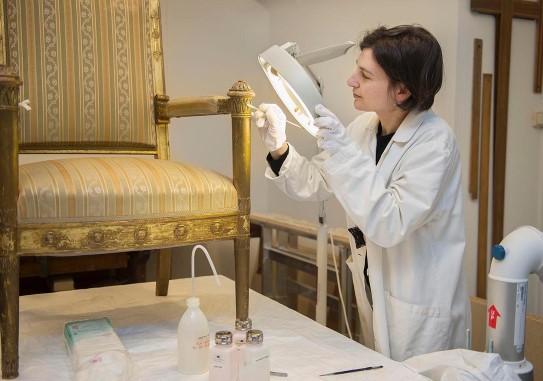
In order to determine how best to take care of an object, the conservator must analyse the object in order to identify the materials and techniques.
Despite the staggering variation in materials and forms, taking care of objects can in general be sorted into two categories: preventive conservation and active (or interventionist) conservation. Preventive conservation pertains to removing or minimizing any factor that could damage the objects, while active conservation entails that the conservator works directly on the object, usually in order to “stabilize” it.
Types of damage for decorative arts and design
Chemical damage
When silver tarnishes, this is the result of a chemical reaction where sulphur in the air reacts with the silver alloy. In that case, the conservator will attempt to reduce the contact with sulphur by storing the silver object along with a substance that bonds more quickly with sulphur than the silver alloy does, or wrap the object in such a way that keeps oxidization to a minimum. By contrast, polishing the object only serves to remove the bluish-black surface, even as it provides the sulphur with a “fresh” surface to bond with.
Mechanical damage
A vase that falls on the floor and breaks is an example of a mechanical damage. In order to try to prevent such damages, the conservator must make plans to ensure that the handling and transport of objects is as gentle as possible.
Biological damage
Biological damages refer primarily to mould and insects. Water damages and high levels of humidity over a period of time act as catalysers that accelerate such damages. It is the conservator’s responsibility to ensure that the humidity surrounding the object does not become too high.
Painting Conservation
The painting conservators at the National Museum are responsible for around 6,500 paintings, ranging in time from the fifteenth century until the present day.
The collection consists mainly of Norwegian paintings on canvas, but also includes important European paintings, icons, and portrait miniatures from various eras, as well as an ever-expanding collection of modern and contemporary works.
The materials and techniques used in these works vary greatly.
The collections include works where the artist has used binding agents such as oil, acryl, egg tempera, glue, PVA dispersions, wax, natural and synthetic resins, and house paint, but also foodstuffs such as gelatine.
Painting surfaces range from primed canvases and wood panels to fibreboards, metals, and plastics.
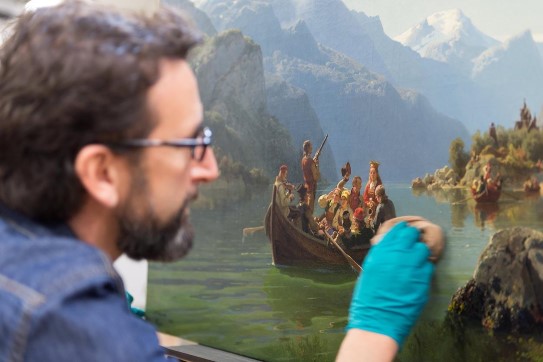
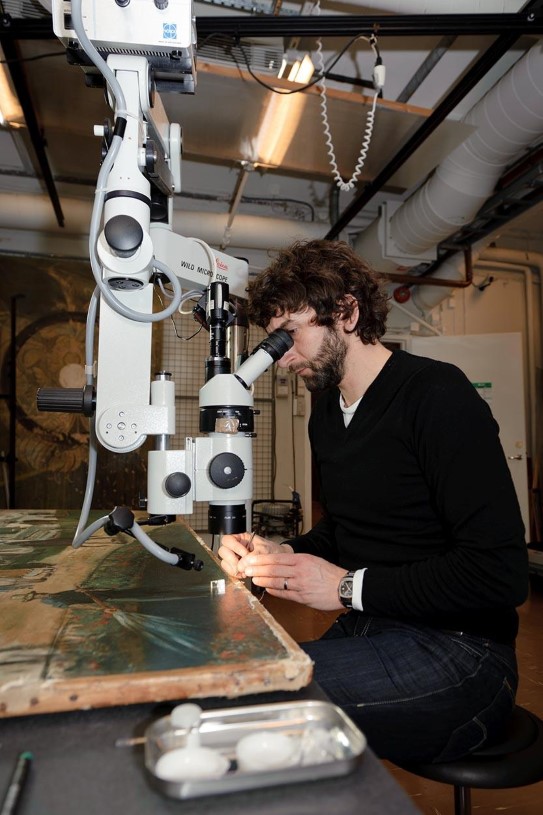
This usually entails inspecting the painting’s surface with a stereo microscope and using lights of varying wavelengths, such as ultraviolet and infrared radiation and X-rays. Conservation may also involve taking small samples of the paint and studying the layering, pigments, binders, and surface material under a microscope with a high degree of magnification, often in the form of a cross-section.
More advanced instruments make it possible today to identify the chemical elements and organic compounds that were originally used in the sample. Interviews with artists represent another key source of information about contemporary art.
Paper
The National Museum possesses a large collection of paper-based materials, including around 50,000 drawings and prints.
The National Museum also owns more than 300,000 architect’s drawings, as well as a large photography collection. The collection ranges from the late fifteenth century until the present day. Currently the museum employs three paper conservators to look after its sizeable and varied collection.
Paper is an intriguing material. However, people often forget how many different types of art are actually made on paper, such as pencil sketches and watercolours; pastels and gouache; prints; drawings in charcoal, chalk, and ink; and many types of photography – and this represents merely a tiny fraction of all the various techniques and materials that one comes across.
Paper’s felt-like structure enables it to be a very strong material, even as it is flexible and absorbent.
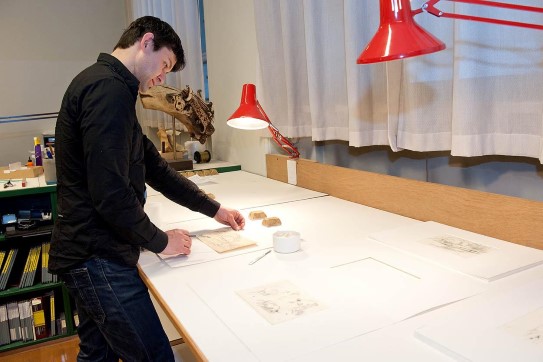
In general, there are three main categories of damages to paper: mechanical, chemical, and biological.
- Mechanical damages, such as tears, holes, folds, or dents, are often due to improper handling, incorrect mounting, or inadequate storage conditions.
- Light is one of the prime culprits of chemical damage. Light, whether it is visible or invisible, can alter the paper so that it becomes brittle and yellowed. Pigments that are not colourfast can fade and potentially even vanish. The air that surrounds us contains gas that may bond with the material and gradually lead to decomposition, and the objects themselves may contain chemical substances that lead to decomposition.
- Since paper is an organic material, inadequate storage conditions may cause it to succumb to biological damages in the form of mould or insects such as silverfish, borer beetles, or booklice.

Textile Conservation
The National Museum has an extensive collection of textiles that range in time from the early Middle Ages until today.
The collection consists mainly of Norwegian and European textiles and historical clothing, tapestries, textile furnishings, and modern decorative arts.
A textile in a museum collection is a source of history. It should be treated accordingly so that it lasts as long as possible and provides us with accurate historical information.
Textile as material
An eclectic textile collection, such as the one the National Museum possesses, features a wide variation in materials and techniques. Natural fibres such as wool, silk, cotton, and linen represent the main group of materials, but synthetic fibres such as viscose rayon, acetate, polyamide, polyester, and acryl are becoming ever more common. In the future we must be prepared for these more recent, “intelligent” materials.
A wide variety of techniques have been used throughout the ages, with woven textiles such as carpets, curtains, upholstery, and clothing textiles representing the largest portion of our collection. Other techniques that feature prominently include knitting, lacework, crochet, and embroidery. Textiles are often used in combination with other materials, such as hide, leather, wood, glass, rock, metal, paper, and plastic. This encourages a good deal of interdisciplinary cooperation with our colleagues from the other material groups.

Treatment of textile objects
Certain objects may require more extensive conservation.
- Before the conservation work itself begins, the object’s history, material composition, and physical condition are thoroughly examined and documented/photographed.
- Which form of treatment that is selected is determined by the extent of the damage, the condition of the material, and whether the object is to be displayed or stored.
- All interventions and changes are documented in writing along with photographs taken before, during, and after conservation. In certain cases, it is necessary to make supplementary drawings.
- It is especially important to document changes, as we must be able to differentiate the original material from later additions that were made so the object could retain its value as a historical source.
